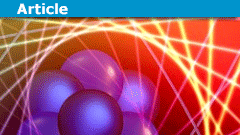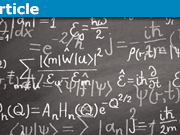Quantum Physics via Quantum Tomography: A New Approach to Quantum Mechanics
This Insight article presents the main features of a conceptual foundation of quantum physics with the same characteristic features as classical physics – except that the density operator takes the place of the classical phase space coordinates position and momentum. Since everything follows from the well-established techniques of quantum tomography (the art and science of determining the state of a quantum system from measurements) the new approach may have the potential to lead in time to a consensus on the foundations of quantum mechanics. Full details can be found in my paper
- A. Neumaier, Quantum mechanics via quantum tomography, Manuscript (2022). arXiv:2110.05294v3
This paper gives for the first time a formally precise definition of quantum measurement that
- is applicable without idealization to complex, realistic experiments;
- allows one to derive the standard quantum mechanical machinery from a single, well-motivated postulate;
- leads to objective (i.e., observer-independent, operational, and reproducible) quantum state assignments to all sufficiently stationary quantum systems.
- The new approach shows that the amount of objectivity in quantum physics is no less than that in classical physics.
The following is an extensive overview of the most important developments in this new approach.
$$
\def\<{\langle} % expectation \def\>{\rangle} % expectation
\def\tr{{\mathop{\rm tr}\,}}
\def\E{{\bf E}}
$$
Table of Contents
Quantum states
The (Hermitian and positive semidefinite) density operator ##\rho## is taken to be the formal counterpart of the state of an arbitrary quantum source. This notion generalizes the polarization properties of light: In the case of the polarization of a source of light, the density operator represents a qubit and is given by a ##2\times 2## matrix whose trace is the intensity of the light beam. If expressed as a linear combination of Pauli matrices, the coefficients define the so-called Stokes vector. Its properties (encoded in the mathematical properties of the density operator) were first described by George Stokes (best known from the Navier-Stokes equations for fluid mechanics) who gave in 1852 (well before the birth of Maxwell’s electrodynamics and long before quantum theory) a complete description of the polarization phenomenon, reviewed in my Insight article ‘A Classical View of the Qubit‘. For a stationary source, the density operator is independent of time.
The detector response principle
A quantum measurement device is characterized by a collection of finitely many detection elements labeled by labels ##k## that respond statistically to the quantum source according to the following detector response principle (DRP):
- A detection element ##k## responds to an incident stationary source with density operator ##\rho## with a nonnegative mean rate ##p_k## depending linearly on ##\rho##. The mean rates sum to the intensity of the source. Each ##p_k## is positive for at least one density operator ##\rho##.
If the density operator is normalized to intensity one (which we shall do in this exposition) the response rates form a discrete probability measure, a collection of nonnegative numbers ##p_k## (the response probabilities) that sum to 1.
The DRP, abstracted from the polarization properties of light, relates theory to measurement. By its formulation it allows one to discuss quantum measurements without the need for quantum mechanical models for the measurement process itself. The latter would involve the detailed dynamics of the microscopic degrees of freedom of the measurement device – clearly out of the scope of a conceptual foundation on which to erect the edifice of quantum physics.
The main consequence of the DRP is the detector response theorem. It asserts that for every measurement device, there are unique operators ##P_k## which determine the rates of response to every source with density operator ##\rho## according to the formula
$$
p_k=\langle P_k\rangle:=\tr\rho P_k.
$$
The ##P_k## form a discrete quantum measure; i.e., they are Hermitian, positive semidefinite and sum to the identity operator ##1##. This is the natural quantum generalization of a discrete probability measure. (In more abstract terms, a discrete quantum measure is a simple instance of a so-called POVM, but the latter notion is not needed for understanding the main message of the paper.)
Statistical expectations and quantum expectations
Thus a quantum measurement device is characterized formally by means of a discrete quantum measure. To go from detection events to measured numbers one needs to provide a scale that assigns to each detection element ##k## a real or complex number (or vector) ##a_k##. We call the combination of a measurement device with a scale a quantum detector. The statistical responses of a quantum detector define the statistical expectation
$$
\E(f(a_k)):=\sum_{k\in K} p_kf(a_k)
$$
of any function ##f(a_k)## of the scale values. As always in statistics, this statistical expectation is operationally approximated by finite sample means of ##f(a)##, where ##a## ranges over a sequence of actually measured values. However, the exact statistical expectation is an abstraction of this; it works with a nonoperational probabilistic limit of infinitely many measured values so that the replacement of relative sample frequencies by probabilities is justified. If we introduce the quantum expectation
$$
\langle A\rangle:=\tr\rho A
$$
of an operator ##A## and say that the detector measures the quantity
$$
A:=\sum_{k\in K} a_kP_k,
$$
it is easy to deduce from the main result the following version of Born’s rule (BR):
- The statistical expectation of the measurement results equals the quantum expectation of the measured quantity.
- The quantum expectations of the quantum measure constitute the probability measure characterizing the response.
This version of Born’s rule applies without idealization to results of arbitrary quantum measurements.
(In general, the density operator is not necessarily normalized to intensity ##1##; without this normalization, we call ##\langle A\rangle## the quantum value of ##A## since it does not satisfy all properties of an expectation.)
Projective measurements
The conventional version of Born’s rule – the traditional starting point relating quantum theory to measurement in terms of eigenvalues, found in all textbooks on quantum mechanics – is obtained by specializing the general result to the case of exact projective measurements. The spectral notions do not appear as postulated input as in traditional expositions, but as consequences of the derivation in a special case – the case where ##A## is a self-adjoint operator, hence has a spectral resolution with real eigenvalues ##a_k##, and the ##P_k## is the projection operators to the eigenspaces of ##A##. In this special case, we recover the traditional setting with all its ramifications together with its domain of validity. This sheds new light on the understanding of Born’s rule and eliminates the most problematic features of its uncritical use.
Many examples of realistic measurements are shown to be measurements according to the DRP but have no interpretation in terms of eigenvalues. For example, joint measurements of position and momentum with limited accuracy, essential for recording particle tracks in modern particle colliders, cannot be described in terms of projective measurements; Born’s rule in its pre-1970 forms (i.e., before POVMs were introduced to quantum mechanics) does not even have an idealized terminology for them. Thus the scope of the DRP is far broader than that of the traditional approach based on highly idealized projective measurements. The new setting also accounts for the fact that in many realistic experiments, the final measurement results are computed from raw observations, rather than being directly observed.
Operational definitions of quantum concepts
Based on the detector response theorem, one gets an operational meaning for quantum states, quantum detectors, quantum processes, and quantum instruments, using the corresponding versions of quantum tomography.
In quantum state tomography, one determines the state of a quantum system with a ##d##-dimensional Hilbert space by measuring sufficiently many quantum expectations and solving a subsequent least squares problem (or a more sophisticated optimization problm) for the ##d^2-1## unknowns of the state. Quantum tomography for quantum detectors, quantum processes, and quantum instruments proceed in a similar way.
These techniques serve as foundations for far-reaching derived principles; for quantum systems with a low-dimensional density matrix, they are also practically relevant for the characterization of sources, detectors, and filters. A quantum process also called a linear quantum filter, is formally described by a completely positive map. The operator sum expansion of completely positive maps forms the basis for the derivation of the dynamical laws of quantum mechanics – the quantum Liouville equation for density operators, the conservative time-dependent Schrödinger equation for pure states in a nonmixing medium, and the dissipative Lindblad equation for states in mixing media – by a continuum limit of a sequence of quantum filters. This derivation also reveals the conditions under which these laws are valid. An analysis of the oscillations of quantum values of states satisfying the Schrödinger equation produces the Rydberg-Ritz combination principle underlying spectroscopy, which marked the onset of modern quantum mechanics. It is shown that in quantum physics, normalized density operators play the role of phase space variables, in complete analogy to the classical phase space variables position and momentum. Observations with highly localized detectors naturally lead to the notion of quantum fields whose quantum values encode the local properties of the universe.
Thus the DRP leads naturally to all basic concepts and properties of modern quantum mechanics. It is also shown that quantum physics has a natural phase space structure where normalized density operators play the role of quantum phase space variables. The resulting quantum phase space carries a natural Poisson structure. Like the dynamical equations of conservative classical mechanics, the quantum Liouville equation has the form of Hamiltonian dynamics in a Poisson manifold; only the manifold is different.
Philosophical consequences
The new approach has significant philosophical consequences. When a source is stationary, response rates, probabilities, and hence quantum values, can be measured in principle with arbitrary accuracy, in a reproducible way. Thus they are operationally quantifiable, independent of an observer. This makes them objective properties, in the same sense as in classical mechanics, positions and momenta are objective properties. Thus quantum values are seen to be objective, reproducible elements of reality in the sense of the famous paper
- A. Einstein, B. Podolsky, and N. Rosen, Can quantum-mechanical description of physical reality be considered complete? Phys. Rev. 47 (1935), 777-781.
The assignment of states to stationary sources is as objective as any assignment of classical properties to macroscopic objects. In particular, probabilities appear – as in classical mechanics – only in the context of statistical measurements. Moreover, all probabilities are objective frequentist probabilities in the sense employed everywhere in experimental physics – classical and quantum. Like all measurements, probability measurements are of limited accuracy only, approximately measurable as observed relative frequencies.
Among all quantum systems, classical systems are characterized as those whose observable features can be correctly described by local equilibrium thermodynamics, as predicted by nonequilibrium statistical mechanics. This leads to a new perspective on the quantum measurement problem and connects to the thermal interpretation of quantum physics, discussed in detail in my 2019 book ‘Coherent Quantum Physics‘ (de Gruyter, Berlin 2019).
Conclusion
To summarize, the new approach gives an elementary, and self-contained deductive approach to quantum mechanics. A suggestive notion for what constitutes a quantum detector and for the behavior of its responses leads to a definition of measurement from which the modern apparatus of quantum mechanics can be derived in full generality. The statistical interpretation of quantum mechanics is not assumed, but the version of it that emerges is discussed in detail. The standard dynamical and spectral rules of introductory quantum mechanics are derived with little effort. At the same time, we find the conditions under which these standard rules are valid. A thorough, precise discussion is given of various quantitative aspects of uncertainty in quantum measurements. Normalized density operators play the role of quantum phase space variables, in complete analogy to the classical phase space variables position and momentum.
There are implications of the new approach for the foundations of quantum physics. By shifting the attention from the microscopic structure to the experimentally accessible macroscopic equipment (sources, detectors, filters, and instruments) we get rid of all potentially subjective elements of quantum theory. There are natural links to the thermal interpretation of quantum physics as defined in my book.
The new picture is simpler and more general than the traditional foundations, and closer to actual practice. This makes it suitable for introductory courses on quantum mechanics. Complex matrices are motivated from the start as a simplification of the mathematical description. Both conceptually and in terms of motivation, introducing the statistical interpretation of quantum mechanics through quantum measures is simpler than introducing it in terms of eigenvalues. To derive the most general form of Born’s rule from quantum measures one just needs simple linear algebra, whereas even to write down Born’s rule in the traditional eigenvalue form, unfamiliar stuff about wave functions, probability amplitudes, and spectral representations must be swallowed by the beginner – not to speak of the difficult notion of self-adjointness and associated proper boundary conditions, which is traditionally simply suppressed in introductory treatments.
Thus there is no longer an incentive for basing quantum physics on measurements in terms of eigenvalues – a special, highly idealized case – in place of the real thing.
Postscript
In the mean time I revised the paper. The new version new version is better structured and contains a new section on high precision quantum measurements, where the 12 digit accuracy determination of the gyromagnetic ration through the observation and analysis of a single electron in a Penning trap is discussed in some detail. The standard analysis assumes that the single electron is described by a time-dependent density operator following a differential equation. While in the original papers this involved arguments beyond the traditional (ensemble-based and knowledge-based) interpretations of quantum mechanics, the new tomography-based approach applies without difficulties.
Full Professor (Chair for Computational Mathematics) at the University of Vienna, Austria










This is a good exposition of part of my thermal interpretation.
Nontrivial and new are here indeed only the implied analysis of what precisely the objective properties are, and how they are encoded in the quantum formalism.
No – there is no contradiction with decoherence since the latter is completely silent about the behavior of single systems.
Decoherence only claims to compute ensemble properties, where the associated reduced density operator diagonalizes (in the pointer basis of selected experiments) after averaging over very high frequencies, which is a consequence of the Riemann–Lebesgue Lemma. The quantum tomography approach and the thermal interpretation refine the story told by decoherence in terms of averages to a different, more detailed story for each single case.
Hydrodynamics is a coarse-grained approximation in which only 1-point functions are retained. Hence it cannot model microscopic correlation experiments. For the analysis of coincidence measurements one needs the dynamics of 2-point functions, which is not obtained correctly in the hydrodynamic approximation.
But one can work instead with the Kadanoff-Baym equations, which are the bilocal analogue of the hydrodynamic equations, and from which one can get the hydrodynamic equations through further coarse-graining.
The underlying determinstic dynamics is that of the ##N##-point functions of quantum field theory, giving a coupled system for ##N=0,1,2,\ldots##. This dynamics is local in the sense of quantum field theory, i.e., conforming to relativistic causality. However, the dynamics is nonlocal in the sense of Bell
since ##N##-point functions for ##N>1## contain more than one spacetime argument. Therefore Bell's analysis does not apply.
and in a related discussion:
As a response you could point to Subsection 4.4 (What is a particle?) in my paper ''Foundations of quantum physics I. A critique of the tradition", where I discuss this question in parallel with a corresponding experiment with classical particles (4mm bullets from an air gun).
There we have exactly the same phenomenon: A radially symmetric source (here an impact impact center) causes a discrete number of cracks, solely through the properties of the detecting matter. The paper [54] is open access and has very nice pictures:
Maybe you can post there a link to the new paper!
The difference of my 2019 paper "Born's rule and meansurement" and my new quantum tomography paper is that the former (30 pages of main text) was a programme (stated on 3 pages in Subsection 2.6) to be executed:
''The material presented suggests a new approach to introductory courses on quantum mechanics''
while the latter (90 pages of main text) is the general part of its execution. I go through many of the main quantum physics topics that must be discussed and show what they mean in terms of the new detector response principle.
Of course, to make it into a text on introductory quantum mechanics, one would need many more examples to which the concepts are applied, and an introduction into how to compute all the stuff treated abstractly in the paper.
Of course one can prepare ensembles within all kinds of QTs and, more importantly, in the lab. Relativistic QFT is among the best tested physical theories ever discovered. This would be impossible to achieve if it were not possible to prepare ensembles of the physical systems described by it, and these are particles and nuclei in particle accelerators, with which you can do scattering experiments with high precision. Another application is atomic physics. A specific quantum-field theoretical result is the explanation of the Lamb shift to several significant digits of accuracy, etc.
I don't understand, how one can claim that one cannot build ensembles within relativistic QFT, given all these successes. After all the first goal in all introductions to QFT is to establish the calculations of S-matrix elements, which precisely describe scattering processes, and obviously these can be realized with high accuracy in the lab.
One can model a single silver atom in this way. But how do you model an ensemble of 100 silver atoms moving at well separated times along a beam by quantum field theory? You cannot prepare multiple instances of a field extending over all of spacetime. The only use! of Born's rule in Weinberg's Vol. 1 (namely where he interprets the scattering amplitutes) doesn't address this issue – scattering has nothing to do with this question!
You also seem to know no place where this is done.
I achieve true simplicity. I find Born's rule far from simple, and very restrictive.
But it is impossible to communicate this to you. You block off all m< attempts with the mantra Born's rule explains all measurements., together with bogus arguments to justify it.
It is not a problem in my setting either. Together with the dynamics implies by the experimental setting, the DRP does it, with much less theoretical baggage than Born's rule:
I still don't understand, what you think to achieve giving up the simple and well-established (as well as very successful) standard foundations of QT. I think that the minimal interpretation without collapse is the only interpretation you need.
You may introduce POVMs, but only if they can be made concrete for the analysis of real-world experiments. I don't see, where they are ever used in real-world applications of QT yet.
You are asserting the opposite of the conclusion of the paper.
It is not a description in terms of the standard interpretation a la Born, since Born's rule is only about ideal von Neumann projective measurements (proof: p.20 of your statistical mechanics lecture notes), and Potel et al. proved that the SGE is not of this kind.
But it is a complete quantum description in terms of the interpretation by my detector response principle!
Dirac describes clearly the physical meaning including the probabilistic interpretation of the quantum state a la Born. You use the same symbols and forbid to interpret them in this standard way but don't give any clear physical interpretation I should use instead. That's why I'm stuck.
Within QFT you can as well prepare single Ag atoms as you can in QM. QFT is also used since it's conception to describe scattering cross sections, and that's also due to the standard interpretation of the quantum state in terms of Born's rule. It's explained in any QFT textbook, e.g., Weinberg, QT of Fields vol. 1.
The point of the paper by Potel is a complete quantum description of the SGE, and there's a probability for spin flips and that's why the SGE is not strictly an ideal von Neumann projection measurement. The point is that it's a complete quantum description in terms of the standard interpretation a la Born.
Each time I discuss it with you I add some new perspective, otherwise the discussion would not be interesting for me. At least I learn through the exchange (not about your view but more about mine), while you seem to be stuck in tradition.
My paper contains as much physics as Dirac's famous book! That you don't see it can only mean that you don't read it with open eyes.
On the quantum mechanical level there is no problem with it.
But a fundamental description would have to come from relativistic quantum field theory, where there are no ensembles. One cannot repeatedly prepare a quantum field extending over all of spacetime.
I don't know of a single paper explaining how the transition in conceptual language from a single quantum field to an ensemble of particles can be justified from the QFT formalism. Maybe you can help me here with a reference?
Sections 2-4 are pure theory without contact to experiment (i.e., before hitting the glass bottle); nothing to complain given their assumptions.
Section 5 interprets the final theoretical result as probability without explaining why they are allowed to do this.
The DRP gives this interpretation of the final theoretical result. On the other hand, Born's rule for projective measurements does not do the job: In Section VI, the authors of the paper write:
[5] is von Neumann's 1932 book (in its 1955 English translation), where he describes measurement exclusively in terms of projection operators.
Thus projective measurements (and hence Born's rule) cannot be applied without making the additional semiclassical approximations proved invalid in the paper.
I also don't understand your problem with the standard description of the SGE in QM. An example is
https://arxiv.org/abs/quant-ph/0409206
No; you just project your understanding of the foundations of quantum physics into my words.
None of my words or underlying concepts uses Born's rule, unless you empty it from all connections to measurements.
Indeed I mention measurement nowhere. Everything mentioned is macroscopic nonequilibrium thermodynamics together with the purely formal definition ##\langle A\rangle:=\mathrm{Tr} \rho A## (which is pure math, not physics), instantiated by taking for ##A## the components of a current to give the physical meaning it has in nonequilibrium thermodynamics. Calling a mathematical definition Born's rule is not appropriate.
The advantage is that eigenvalues play no role, and that nonprojective measurements are covered without any additional effort. Thus my approach is both simpler and more general than working with Born's rule, and the explanatory value is higher.
Such a complete measurement cannot be done for most quantum systems (except for those with very few degrees of freedom). My approach does not need such fictions.
Most physics students in the lab will not do SGE with single silver atoms, but with continuous beams of silver. Therefore I only discussed the standard Stern-Gerlach experiment, as performed by them. This involves no ensemble but a silver field in the form of a dispersed beam.
Really? I get the same result not from Born's rule but from the detector response principle DRP, without using eigenvalues or projections.
Maybe you will call the DRP Born's rule to save your view. Then we agree, except for the terminology.
In any case, introducing the DRP is much more intuitive than the introduction of Born's rule in your statistical physics lecture notes:
which is full of nonintuitive formal baggage that falls from heaven without any motivation. As only reference you give Dirac's famous book; I have the third edition from 1947. There he introduces eigenvectors on p.29, without any motivation, and states Born's rule in (45) on p.47, with formal guesswork as only motivation, and in a very awkward way, where one cannot recognize how it is related to your formulation. A more digestible version comes later in (51) on p.73,
but this is equivalent to yours only in the case of nondegenerate eigenvalues. The name Born's rule is nowhere mentioned in the book – so little importance does Dirac give to it!
Conclusion: In the foundations favored by you the students first have to swallow ugly toads, just based the promise that it will ultimately result in a consistent quantum theory later….
The DRP, in contrast, needs no eigenvalues at all, no separate consideration of degenerate cases, not even self-adjoint operators (themselves nontrivial to define but needed for the spectral resolution). The little stuff needed is simple and easy to motivate from Stokes' treatment of polarization in 1852.
The primary semiclassical approximation needed is the one that goes from quantum field theory to an ensemble of a sequence of single atoms moving along a beam and arriving at the bottle.
I don't know of a single paper explaining in detail how this transition in conceptual language can be justified from the QFT formalism. Maybe you can help me here with a reference?
$$P(a_{1j},\ldots,a_{dj}) = \langle a_{1j},a_{2j},\ldots, a_{dj}|\hat{\rho}|a_{1j},a_{2j},\ldots, a_{dj} \rangle.$$
The usual qualifications apply if you have operators which have a continuous (parts of their) spectrum.
Sure, but all your words are just using Born's rule. I know that you deny that your expectation-value brackets have a different than the usual straight-forward meaning of Born's rule, but I don't see what's the merit should be not to accept Born's rule (of course in its general form for general states, i.e., also for mixed states).
If you do the SGE with single silver atoms, there's no other way to get from the formalism to the observations than Born's rule, and it's one of the very few examples, where no semiclassical approximations are needed. You can solve the Schrödinger equation in this case exactly assuming a simplified magnetic field or use numerics.
I didn't decide against the Ehrenfest picture.
I am speaking here from a pragmatic point of view. Quantum field theory in the form of the standard model is known to be the basis of all our quantum physics. It is phrased almost exclusively in the Heisenberg picture, without any wave functions present. In my post I intended to refer implicitly to this, currently most fundamental, setting.
QFT can be reformulated in the Schrödinger picture via wave functionals, but this is hardly ever used in the literature.
All that quantum field theory calculates are N-point functions and stuff derived from these (like scattering cross sections and transport coefficients). These are the stuff that belong to the Ehrenfest picture. Thus the latter is the unifying umbrella.
But (unlike the Heisenberg and Schrödinger picture) the designation 'Ehrenfest picture' is little used in the literature. Since in discussions it is better to refer to well-known things where these convey the same information as less known concepts, I used the Heisenberg picture with which every QFT specialist is thorougly familiar.
Not on the most fundamental level.
The true foundations of quantum mechanics is relativistic quantum field theory in the Heisenberg picture. There a beam of silver is given by the 1-point function ##\langle j(x)\rangle## of the silver 4-current ##j(x)## being peaked in a neighborhood of the beam. Silver is transported along the beam as described (in principle) exactly by the Kadanoff-Baym equations. In its coarse-grained approximation it is described by hydromechanics. The amount of silver deposited at some position is the integral of the intensity ##I(x)=\langle j_0(x)\rangle## of the silver beam at that position. This gives a quantitatively valid explanation of what happens when a silver beam hits a glass bottle. Together with standard semiclassical dynamical reasoning, this fully explains the original Stern-Gerlach experiment.
This is completely analogous to the treatment of polarized light in Section 2.1 of my tomography paper, where the current is modeled by the 4 components of the relativistic Pauli vector ##\sigma##. The spacetime dependence is suppressed in this simple qubit setting; otherwise (as discussed in detail in the book by Mandel and Wolf) again a field theoretic current would figure.
Thus on the most fundamental level, a beam of silver is – just like a beam of light – a field, not an ensemble of silver atoms.
Describing a beam of silver (or a beam of light) by an ensemble of individual particles following each other along the beam, so that Born's rule is applicable, requires additional, theoretically murky semiclassical approximations. Already the particle concept in relativistic quantum field theory is somewhat dubious, as you well know. That something is wrong with your recipe can also be seen from the fact that your recipe cannot be applied to the detection of photons, which follow experimentally exactly the same pattern, although one can not even define the wave function that your recipe requires.
Thus the approach pursued in my paper is much to be preferred. In addition, it has the advantage of being simpler to motivate and to work with!
You yourself conceded that Born's rule is not involved, dynamics does everything!
We discussed the Stern- Gerlach experiment. It didn't need Born's rule, so it doesn't need POVMs.
But both can be used if one likes, and unlike the former, the latter gives a correct account of imperfections.
Look at [33, Example 1, p.7] to see a lengthy discussion in terms of POVMs.
Perhaps optimal quantum discrimination is a POVM concrete enough for you. This particular POVM can be realized using a beam splitter, as described in more generality in Section 4.1 of my paper.
This is a theorem, not just a claim. You can easily convince yourself of its validity.
Because for the idealized textbook version the POVM is projective and for more realistic version it is no longer that simple (but given in the above reference). I don't want to copy long explanations from books that you can easily read yourself.
The definition of intensity and the DRP is very simple and transparent (and more general) compared to Born's rule. It is enough to specify the testable predictions of the textbook version of the Stern-Gerlach experiment. And it leads directly to POVMs (though in toy examples like this the POVM turns out to be projective due to the idealizations involved).
Make your pick by Occam's razor!
Stern and Gerlach didn't use a photoplate but a simple glass bottle. The silver arrived and stuck there. Just like when you would use a beam of paint.
Yes, and I don't understand, where POVMs are needed to explain real-world experiments. That's why I'm asking!
For me all QT does is to predict the probabilities for the outcome of measurements, given a preparation procedure. Here the preparation procedure is to produce a silver-atom beam with an oven and letting this beam go through an inhomogeneous magnetic field, which is designed to split the beam with high accuracy in two partial beams, where the position in a certain region is entangled with the value of the spin component in direction of this magnetic field.
The measurement itself, irreversibly storing the result, is when the silver atoms are absorbed at the photoplate making a spot at the corresponding place. Then you can count the spots and compare with the probability distribution predicted by the calculation. Indeed there's no POVM needed, and the "projection operators" I use are simply to calculate the probability distribution by Born's rule, ##P(\vec{x})=\mathrm{Tr} (\hat{\rho} |\vec{x} \rangle \langle x|)=\langle \vec{x} |\hat{\rho} \vec{x} \rangle=\rho(\vec{x},\vec{x})##.
Of course, before the Ag atom hits the photoplate the procedure is in principle reversible, and no measurement has taken place. Nevertheless, I have to use Born's rule to predict the probability distribution for where the atom will hit the photo plate. Calculations in a Hilbert space are no measurements, of course.
Exactly. So where do I need a POVM?
Of course it's needed. What else than the probability distributions should be the testable prediction for the SGE?
I don't say Born's rule is involved in any measurement. It's giving the predictions for what will be measured. I still don't understand what's unexplained in this standard description of the SGE and where I need POVMs to predict the outcome of the measurement.
But my point is that the model dynamics already predicts exactly two silver beams at the right spots, with intensities given by the preparation. This only depends on reversible quantum theory – the Schrödinger equation and the definition of intensity analogous to what my quantum tomography paper does for photons in Section 2.1. So POVMs or projection operators don't enter at this stage.
The whole setting is in principle reversible, hence no measurement has taken place. Therefore this part cannot involve Born's rule, which is explicitly about measurement, and has nothing to say in the reversible case.
The subsequent measurement of the silver intensities on the screen is a purely classical process, of the same kind as measuring where and how much paint falls on a screen when sprayed with two faint beams of paint.
Thus the whole experiment nowhere needs quantum measurements for its quantitative understanding! Hence Born's rule is not needed anywhre!
Of course you can mumble 'Born's rule is involved in any measurement'. But this doesn't change anything and adds nothing to the explanation.